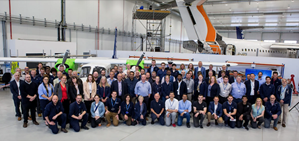News
Cranfield Aerospace Solutions unveils refurbished facilities to develop zero-emissions aircrafts
Cranfield Aerospace Solutions (CAeS) unveiled its newly refurbished hangar and R&D facility at the heart of Cranfield University campus. The facility, leased by CAeS has undergone major refurbishments as part of Cranfield University’s decarbonization plan, with significant investment into reducing the building’s carbon footprint.
The modernized and more environmentally friendly hangar will be used to modify CAeS’ Britten-Norman Islander, bound for conversion to a H2-electric propulsion system for entry into service in 2026.
It will also be used by CAeS to develop the procedures and processes required for the maintenance of future H2-powered aircraft, while still maintaining its conventional MRO function which specializes in wide-bodied and light aircraft such as Diamond DA 40/42 Series and Piper Singles and Twin Piston Engine Series.
CEO of CAeS, Paul Hutton said, “This modernized hangar becomes a classroom of possibilities, where we will not only deliver the intricacies of zero emissions propulsion but also pioneer maintenance procedures for H2-powered aircraft. Our engineers and technologists, fueled by curiosity and a passion for sustainability, stand ready to lead the charge at the most exciting stage of our growth yet.”
Aviation Minister Baroness Vere said, “Cranfield is a historic site for UK aviation: from training RAF pilots and the formation of the College of Aeronautics, to now being at the forefront of emerging technologies like H2 fuel-cell aircraft.
“It is apt therefore that these facilities open a year on from publication of the Jet Zero Strategy. Decarbonizing aviation will be challenging, but the experience and ingenuity of UK engineers will see us through. And I am proud to see UK companies leading the way.”
This exciting unveiling constitutes the beginning of a bright trajectory for CAeS as the company closes in on a proposed merger with British aircraft manufacturer, Britten-Norman, and looks to build on the conversion of the BN Islander with a series of future aircraft optimized around zero-emissions technology.


